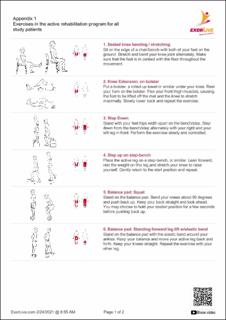| dc.contributor.author | Straume-Næsheim, Truls Martin | |
| dc.contributor.author | Randsborg, Per-Henrik | |
| dc.contributor.author | Mikaelsen, Jan Rune | |
| dc.contributor.author | Årøen, Asbjørn | |
| dc.date.accessioned | 2022-05-27T14:09:18Z | |
| dc.date.available | 2022-05-27T14:09:18Z | |
| dc.date.created | 2022-04-12T17:39:53Z | |
| dc.date.issued | 2022 | |
| dc.identifier.citation | Knee Surgery, Sports Traumatology, Arthroscopy. 2022, Artikkel 06934-3. | en_US |
| dc.identifier.issn | 0942-2056 | |
| dc.identifier.uri | https://hdl.handle.net/11250/2996526 | |
| dc.description | This article is licensed under a Creative Commons Attribution 4.0 International License, which permits use, sharing, adaptation, distribution and reproduction in any medium or format, as long as you give appropriate credit to the original author(s) and the source, provide a link to the Creative Commons license, and indicate if changes were made. The images or other third party material in this article are included in the article's Creative Commons license, unless indicated otherwise in a credit line to the material. If material is not included in the article's Creative Commons license and your intended use is not permitted by statutory regulation or exceeds the permitted use, you will need to obtain permission directly from the copyright holder. | en_US |
| dc.description.abstract | Purpose: Isolated reconstruction of the medial patellofemoral ligament (MPFL-R) has become the predominant stabilizing procedure in the treatment of recurrent lateral patellar dislocation (LPD). To minimize the risk of re-dislocations, isolated MPFL-R is recommended in patients with no significant trochlea dysplasia and tibial tuberosity trochlear groove distance < 20 mm on computed tomography (CT). Incidentally, these criteria are the same that are used to identify first time LPD patients where conservative treatment is recommended. The purpose of this study was therefore to compare MPFL-R with active rehabilitation for patients with recurrent LPD (RLPD) in absence of the above mentioned underlying anatomical high-risk factors for further patellar dislocations.
Methods: RLPD-patients aged 12–30 without underlying anatomical high-risk factors for further LPD were randomized into treatment either with isolated MPFL-R or active rehabilitation provided and instructed by a physiotherapist. All patients underwent diagnostic arthroscopy for concomitant problems. The main outcome measure was persistent patellar instability at 12 months. Knee function at baseline and 12 months was asses using the following patient reported outcomes measures (PROMS); KOOS, Kujala, Cincinnati knee rating, Lysholm score and Noyes sports activity rating scale.
Results: Between 2010 and 2019, 61 patients were included in the study (MPFL-R, N = 30, Controls, N = 31). Persistent patellar instability at 12 months was reported by 13 (41.9%) controls, versus 2 (6.7%) in the MPFL-group (RR 6.3 (95% CI 1.5–25.5). No statistically significant differences in activity level were found between the MPFL-group and the Controls at neither baseline nor follow up. The patients with persistent instability at 12 months did not score significantly lower on any of the PROMs compared to their stable peers, regardless of study group.
Conclusion: Patients with recurrent patellar dislocations have a six-fold increased risk of persistent patellar instability if treated with active rehabilitation alone, compared to MPFL-R in combination with active rehabilitation, even in the absence of significant anatomical risk factors. Active rehabilitation of the knee without MPFL-R improves patient reported knee function after one year, but does not protect against persistent patellar instability.
Level of evidence: 1. | en_US |
| dc.language.iso | eng | en_US |
| dc.subject | active rehabilitation | en_US |
| dc.subject | adolescence | en_US |
| dc.subject | conservative treatment | en_US |
| dc.subject | functional outcome | en_US |
| dc.subject | medial patellofemoral ligament reconstruction | en_US |
| dc.subject | MPFL reconstruction | en_US |
| dc.subject | patellar dislocation | en_US |
| dc.title | Medial patellofemoral ligament reconstruction is superior to active rehabilitation in protecting against further patella dislocations | en_US |
| dc.type | Peer reviewed | en_US |
| dc.type | Journal article | en_US |
| dc.description.version | publishedVersion | en_US |
| dc.rights.holder | © The Author(s) 2022 | en_US |
| dc.source.pagenumber | 10 | en_US |
| dc.source.journal | Knee Surgery, Sports Traumatology, Arthroscopy | en_US |
| dc.identifier.doi | 10.1007/s00167-022-06934-3 | |
| dc.identifier.cristin | 2017091 | |
| dc.description.localcode | Institutt for idrettsmedisinske fag / Department of Sports Medicine | en_US |
| dc.source.articlenumber | 06934-3 | en_US |
| cristin.ispublished | true | |
| cristin.fulltext | original | |
| cristin.qualitycode | 1 | |

